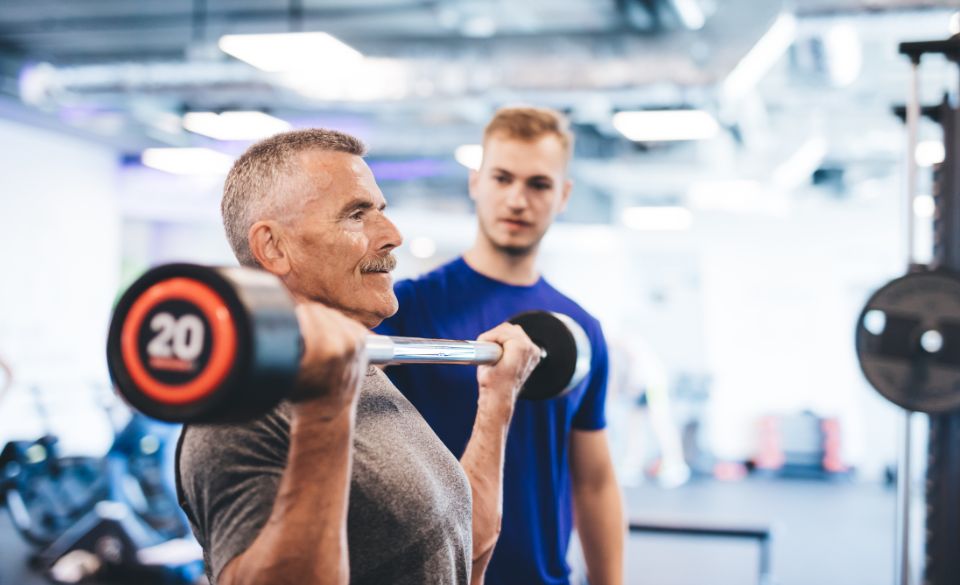
Weight Training for Aging Adults: Maintaining Strength and Independence
Page Contents
As we age, maintaining strength and independence becomes increasingly important for maintaining a high quality of life. While many associate weight training with younger individuals, it is equally vital for aging adults. In fact, weight training can play a significant role in combating age-related muscle loss, improving bone density, enhancing balance and coordination, and ultimately helping older adults maintain their independence. In this article, we will explore the benefits of weight training for aging adults and provide guidance on safe and effective weight training practices.
Combating Age-Related Muscle Loss
As we age, it is common to experience a gradual loss of muscle mass and strength, known as age-related muscle loss or sarcopenia. This natural process can have a significant impact on our physical function, mobility, and overall quality of life. However, the good news is that combating age-related muscle loss is possible through various strategies, with weight training being a particularly effective approach.
Weight training, also known as resistance training or strength training, involves engaging in exercises that target the muscles using external resistance such as weights, resistance bands, or body weight. This type of exercise is a powerful tool for combating age-related muscle loss because it stimulates muscle growth and helps maintain muscle strength.
When we perform weight training exercises, the muscles are placed under tension, creating microscopic damage to the muscle fibers. In response to this damage, our bodies initiate a repair process that involves rebuilding and strengthening the muscles. Over time, with consistent weight training, this adaptive process leads to muscle growth and increased strength.
Weight training provides several benefits in combating age-related muscle loss. Firstly, it helps to preserve existing muscle mass. By engaging in resistance exercises, we signal to our body that the muscle tissue is necessary, which helps prevent its breakdown. This is crucial because as we age, our bodies become less efficient at building and maintaining muscle, making preservation of muscle mass a priority.
Secondly, weight training promotes muscle growth. When we challenge our muscles with resistance, they adapt and become stronger. This is achieved by increasing the size and number of muscle fibers, as well as improving their overall quality. This growth and strengthening of the muscles not only helps combat age-related muscle loss but also enhances physical performance and functional abilities.
Additionally, weight training improves muscular endurance. It enables the muscles to work efficiently for longer periods, reducing fatigue and increasing stamina. This is particularly beneficial for activities of daily living and maintaining independence as we age.
It is worth noting that weight training is not solely about lifting heavy weights. It can be tailored to individual needs and abilities. For older adults, it is important to focus on proper form and technique, gradually increasing resistance, and incorporating exercises that target major muscle groups.
Improving Bone Density
Maintaining strong and healthy bones is crucial, especially as we age. One of the key factors in bone health is bone density, which refers to the amount of mineral content and strength of our bones. Adequate bone density is essential for preventing fractures, maintaining mobility, and overall well-being. Thankfully, there are effective strategies for improving bone density, and one such strategy is through weight training.
Weight training, also known as resistance training or strength training, involves performing exercises that target the muscles using external resistance such as weights, resistance bands, or body weight. While weight training is commonly associated with building muscle, it also plays a significant role in improving bone density.
When we engage in weight training exercises, the muscles exert force on the bones, creating mechanical stress. This stress is transmitted to the bones and triggers a response from our body to strengthen and rebuild bone tissue. Through this process, known as bone remodeling, weight training stimulates the deposition of minerals like calcium and increases bone density.
Weight training is particularly effective for improving bone density because it is a weight-bearing exercise. Weight-bearing exercises involve activities that force you to work against gravity while standing or moving. These exercises create impact and stress on the bones, promoting the development of new bone tissue and enhancing bone strength.
Including weight-bearing exercises like weightlifting, lunges, squats, and step-ups in a well-rounded exercise routine can have a positive impact on bone health. These exercises place stress on the bones in a controlled manner, helping to maintain or even increase bone density. It is important to note that the intensity and load of the weight training should be appropriate for individual capabilities and gradually progressed over time.
Additionally, weight training can have a positive impact on bone health by improving overall strength, coordination, and balance. Strong muscles and good balance are essential for preventing falls and reducing the risk of fractures, especially in older adults.
To optimize bone density improvement, it is recommended to combine weight training with weight-bearing aerobic exercises like walking or jogging, as well as proper nutrition. A balanced diet rich in calcium, vitamin D, and other bone-supporting nutrients is important for overall bone health.
However, it is crucial to keep in mind that individuals with pre-existing conditions or concerns regarding bone health should consult with their healthcare provider before starting a weight training program. They can provide guidance and recommendations based on individual needs and considerations.
Enhancing Balance and Coordination
Maintaining balance and coordination is essential for preventing falls and maintaining independence in older adults. Weight training can significantly improve these aspects by targeting stabilizer muscles and enhancing overall body control. Incorporating exercises that challenge balance, such as single-leg squats, standing dumbbell presses, and stability ball exercises, can improve proprioception and stability. It is advisable to perform these exercises under the guidance of a qualified fitness professional to ensure safety and proper form.
Best Weight Training Exercises For Aging Adults
When it comes to weight training for aging adults, it is important to focus on exercises that are safe, effective, and suitable for individual capabilities. The following are some of the best exercises that can be incorporated into a weight training program for aging adults:
Squats: Squats are a compound exercise that targets multiple muscle groups, including the quadriceps, hamstrings, and glutes. They help improve lower body strength, stability, and mobility, which are essential for maintaining independence and performing daily activities.
Chest Press: The chest press exercise targets the chest muscles, shoulders, and triceps. This exercise helps improve upper body strength, particularly in the chest and pushing movements. It can be performed using dumbbells, resistance bands, or weight machines, depending on individual preference and equipment availability.
Rows: Rowing exercises, such as bent-over rows or seated rows, target the back muscles, including the upper back, mid-back, and lats. These exercises help improve posture, upper body strength, and balance out the pushing movements from exercises like the chest press.
Step-Ups: Step-ups are a functional lower body exercise that simulates climbing stairs. This exercise strengthens the legs, particularly the quadriceps and glutes, and improves balance and stability. Step-ups can be performed using a step platform, stairs, or a stable elevated surface.
Overhead Press: The overhead press targets the shoulder muscles and the muscles of the upper back. It helps improve shoulder strength, stability, and posture. It can be performed using dumbbells, a barbell, or even resistance bands.
Planks: Planks are an excellent exercise for strengthening the core muscles, including the abdominal muscles, back muscles, and stabilizing muscles. They improve core stability, posture, and support proper alignment during daily activities.
Leg Press: The leg press is a lower body exercise that targets the quadriceps, hamstrings, and glutes. It is a great alternative to squats for individuals with limited mobility or joint issues. The leg press machine allows for controlled movements and can be adjusted to accommodate different fitness levels.
Bicep Curls: Bicep curls target the muscles of the upper arm and help improve arm strength and functionality. They can be performed using dumbbells, resistance bands, or cable machines.
Remember to start with lighter weights and gradually increase the intensity and resistance as strength and comfort levels improve. Proper form and technique should always be prioritized to avoid injury. It is also recommended to work with a qualified fitness professional who can provide guidance, ensure correct exercise execution, and customize the program based on individual needs and abilities.
Safe and Effective Weight Training
Before beginning a weight training program, it is important for aging adults to consult with their healthcare provider and obtain clearance for exercise. Once cleared, it is recommended to start with light weights or resistance bands and gradually progress as strength and confidence increase. Proper form and technique are essential to prevent injuries, so working with a qualified fitness professional to learn proper lifting techniques is highly beneficial. Additionally, it is important to listen to the body, allowing for adequate rest and recovery between workouts, and modifying exercises as needed to accommodate individual capabilities.
Final Words
Weight training holds immense value for aging adults in maintaining strength, independence, and overall well-being. By engaging in regular resistance exercises, older adults can combat age-related muscle loss, improve bone density, enhance balance and coordination, and ultimately enjoy a higher quality of life. With proper guidance, considerations for safety, and gradual progression, weight training can be a safe and effective practice for older adults. So, let’s embrace the power of weight training and age gracefully, maintaining strength and independence for years to come.
Remember, it is always recommended to consult with a healthcare professional or qualified fitness trainer before starting any exercise program, especially for individuals with pre-existing health conditions or injuries.



